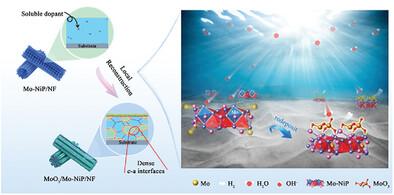当前位置:
X-MOL 学术
›
Adv. Energy Mater.
›
论文详情
Our official English website, www.x-mol.net, welcomes your
feedback! (Note: you will need to create a separate account there.)
Dense Crystalline-Amorphous Nano-Interfaces Derived from Local Reconstruction for Alkaline Hydrogen Evolution
Advanced Energy Materials ( IF 24.4 ) Pub Date : 2024-12-13 , DOI: 10.1002/aenm.202404246
Jianhang Nie 1 , Jinghui Shi 1 , Lei Li 1 , Meng‐Yuan Xie 1 , Zhen‐Yang Ouyang 1 , Ming‐Hua Xian 1 , Gui‐Fang Huang 1, 2 , Hui Wan 1, 3 , Wangyu Hu 4 , Wei‐Qing Huang 1
Advanced Energy Materials ( IF 24.4 ) Pub Date : 2024-12-13 , DOI: 10.1002/aenm.202404246
Jianhang Nie 1 , Jinghui Shi 1 , Lei Li 1 , Meng‐Yuan Xie 1 , Zhen‐Yang Ouyang 1 , Ming‐Hua Xian 1 , Gui‐Fang Huang 1, 2 , Hui Wan 1, 3 , Wangyu Hu 4 , Wei‐Qing Huang 1
Affiliation

|
The crystalline-amorphous (c-a) interface can provide abundant accessible active sites and high intrinsic activity for hydrogen evolution reaction (HER); however, conventional methods only produce sparse c-a interface between hetero-phases. Here, a novel soluble dopant-induced local self-reconstruction strategy to yield dense c-a nano-interfaces is presented, as demonstrated by Mo doped-NiP pre-catalyst. During the cathodic polarization in alkaline electrolyte, the Mo dopant initially dissolves, generating abundant nano-voids within the NiP nanosheets; and subsequently forms in situ ultrafine amorphous MoO3 nanoparticles, ranging from 2 to 4 nm in size, embedded in the crystalline NiP nanosheets. Compared with the conventional surface reconstruction that only generates sparse c-a interface, the proposed “dopant-dissolution-redeposition”, occurred in the surface and inner local regions around dopants, can yield dense c-a nano-interface. Theoretical calculations reveal that the c-a interface can efficiently modulate the electronic structure of interfacial sites and lower the HER overpotential. Benefiting from the dense c-a nano-interface, the amorphous/crystalline MoO3/Mo-NiP exhibits outstanding HER performance, achieving current density of 10 mA cm−2 at ultra-low overpotentials of 26 mV with long-term stability in 1 M KOH. This work provides a basis for tuning the composition-structure-property relationships of materials from both surface and interior.
中文翻译:

来自碱析氢的局部重构衍生的致密结晶-非晶态纳米界面
结晶-非晶态 (c-a) 界面可为析氢反应 (HER) 提供丰富的可及活性和高本征活性;然而,传统方法只能在异质相之间产生稀疏的 C-A 界面。在这里,提出了一种新的可溶性掺杂剂诱导的局部自重构策略,以产生致密的 c-a 纳米界面,如 Mo 掺杂 NiP 预催化剂所证明的那样。在碱性电解质中的阴极极化过程中,Mo 掺杂剂最初溶解,在 NiP 纳米片内产生丰富的纳米空隙;随后在原位形成超细无定形 MoO3 纳米颗粒,尺寸范围为 2 至 4 nm,嵌入晶体 NiP 纳米片中。与仅产生稀疏 c-a 界面的常规表面重构相比,所提出的“掺杂剂-溶解-再沉积”发生在掺杂剂周围的表面和内部局部区域,可以产生致密的 c-a 纳米界面。理论计算表明,c-a 界面可以有效地调节界面位点的电子结构并降低 HER 过电位。得益于致密的 c-a 纳米界面,非晶/结晶 MoO3/Mo-NiP 表现出出色的 HER 性能,在 26 mV 的超低过电位下实现了 10 mA cm-2 的电流密度,并在 1 M KOH 中具有长期稳定性。这项工作为调整表面和内部材料的成分-结构-性能关系提供了基础。
更新日期:2024-12-13
中文翻译:

来自碱析氢的局部重构衍生的致密结晶-非晶态纳米界面
结晶-非晶态 (c-a) 界面可为析氢反应 (HER) 提供丰富的可及活性和高本征活性;然而,传统方法只能在异质相之间产生稀疏的 C-A 界面。在这里,提出了一种新的可溶性掺杂剂诱导的局部自重构策略,以产生致密的 c-a 纳米界面,如 Mo 掺杂 NiP 预催化剂所证明的那样。在碱性电解质中的阴极极化过程中,Mo 掺杂剂最初溶解,在 NiP 纳米片内产生丰富的纳米空隙;随后在原位形成超细无定形 MoO3 纳米颗粒,尺寸范围为 2 至 4 nm,嵌入晶体 NiP 纳米片中。与仅产生稀疏 c-a 界面的常规表面重构相比,所提出的“掺杂剂-溶解-再沉积”发生在掺杂剂周围的表面和内部局部区域,可以产生致密的 c-a 纳米界面。理论计算表明,c-a 界面可以有效地调节界面位点的电子结构并降低 HER 过电位。得益于致密的 c-a 纳米界面,非晶/结晶 MoO3/Mo-NiP 表现出出色的 HER 性能,在 26 mV 的超低过电位下实现了 10 mA cm-2 的电流密度,并在 1 M KOH 中具有长期稳定性。这项工作为调整表面和内部材料的成分-结构-性能关系提供了基础。







































 京公网安备 11010802027423号
京公网安备 11010802027423号